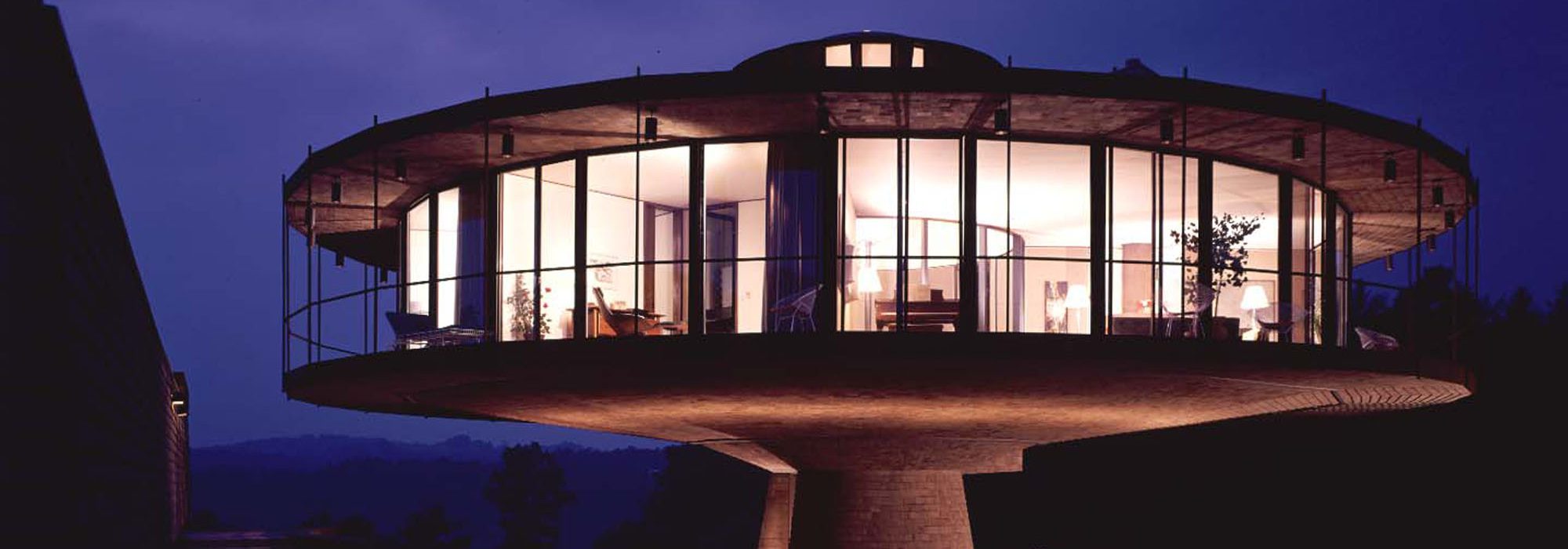WILTON, Conn.— With the press of a button, Richard Foster can make the world spin faster. Or slower. Or in reverse. Or back and forth. ”People ask me to do it all the time,” he says.
Suddenly, a faint soothing hum fills the living room. The floor gently vibrates. Outside the picture window, the hills begin to move. Mr. Foster’s house is revolving. ”Get you a drink?” he asks. ”We should have quite a sunset.”
Something there is, as Robert Frost would say, about modern architecture, especially here in the exurban environs of Fairfield County. Remember Phil Donahue, the TV star? Remember what he did last summer in nearby Westport when he got tired of looking at the nouveau-Flintstones-style house next door to his stately Tudor mansion? Right, he bought it. And tore it down. People here appreciate barns, not Bauhaus.
Considering that esthetic, Mr. Foster’s house should have been leveled by the colonial-home crowd not long after it was built 20 years ago. This, after all, is a round structure that most closely resembles either a flying saucer on a pedestal, an Alexander Calder sculpture of a mushroom or maybe George Jetson’s house. And it revolves. Yes, like one of those ”Top of the ” restaurants. (Fill in a city, park, plaza or landmark.) Somehow, though, Mr. Foster’s experimental home has been accepted here. ”People are quite tolerant of it,” said Robert Flouton, Wilton’s zoning enforcement officer and a design expert who once worked with Frank Lloyd Wright. ”They think that it’s great someone’s living in there – other than themselves.”
Some residents even gush about the building as if it were the town’s own postmodern Monticello.
”I think of it as something very special,” said Sheila Wakoff, a real-estate broker.
The excitement over the revolving house has subsided over the years. In the early days, gawkers would regularly gather outside. Some sightseers even rang the doorbell to ask for an unscheduled tour. Others, often finding the door unlocked, wandered inside on their own. ”Fortunately, we are pretty far from the road,” said Mr. Foster, a Greenwich-based commercial architect who designed the house and has lived in it with his wife and children since it was completed.
The eight-room structure of steel, wood and glass – one of only three known revolving houses in the world and the only one in the United States – sits on six acres and is conservatively estimated to be worth slightly more than $1 million.
Mr. Foster, who credits the Space Needle at the Seattle World’s Fair as his inspiration, said he chose to build a revolving house because the views were too wonderful to be wasted on a stationary home. With a rotating house, he can spin at a maximum speed of one turn every 48 minutes. That works out to a little less than 0.05 miles per hour (one-twentieth of one m.p.h.). Not so fast that you have to grab hold of the Mies van der Rohe-designed chairs, but still quick enough to make an unwarned guest wonder about flashbacks or spiked drinks.
”Some people are startled,” Mr. Foster said. ”But we’ve had people who don’t believe it’s moving, too.”
The movement, generated through a one-and-a-half-horsepower motor and a 14-foot ball-bearing assembly, hardly puts a dent in the electricity bill, either. ”It’s no more than two refrigerators going,” said Mr. Foster, who invented the word ”circambulent” to describe his one-story, 72-foot-diameter home, which rests on a 10-foot-high concrete cone. The biggest problem comes when a stiff wind rips through the valley and provides a little friendly updraft. ”You do feel it,” he said.
Perhaps Mr. Foster’s house should not be considered such an oddity here in this tradition-worshiping county, where stoic New England sensibilities and monied New York mania coexist. ”There is good art and bad art,” Mr. Foster said, momentarily stopping the spin so the living room window framed a picture of contrails and cirrus clouds carving the twilight’s magenta-tinged sky. ”Whether it’s contemporary or whatever really doesn’t matter.”
Aptly, just a few country roads away from Mr. Foster’s house lies New Canaan, where a generation ago Philip Johnson and a few creativity-crazed cohorts built some rather bizarre homes.
Probably the most notable of their works is Mr. Johnson’s 40-year-old see-through house. It’s called the Glass House. It became part of the National Trust for Historic Preservation in 1986. And, like Mr. Foster’s home, it is praised more often than pilloried.
Fortunately, neither one was built next to Phil Donahue’s house.

